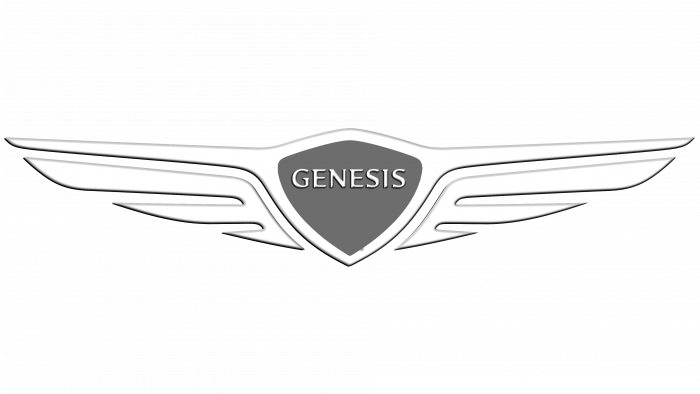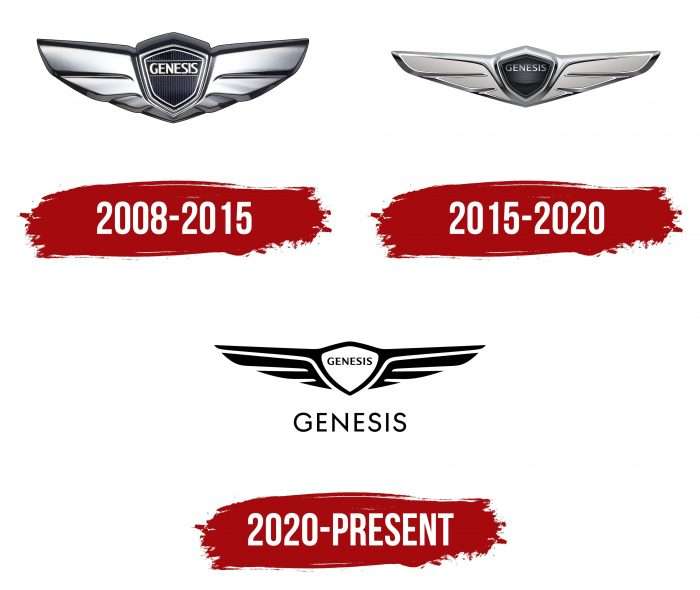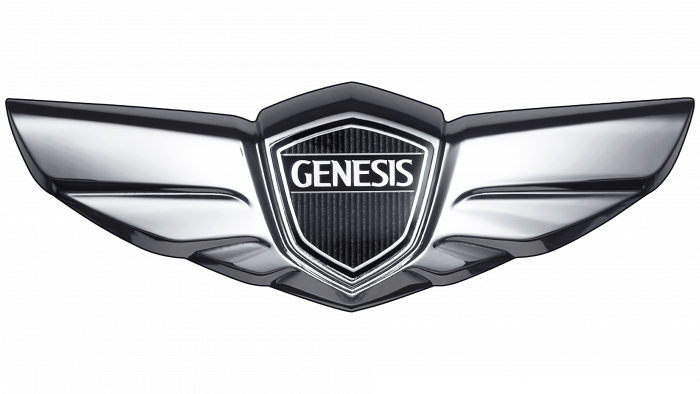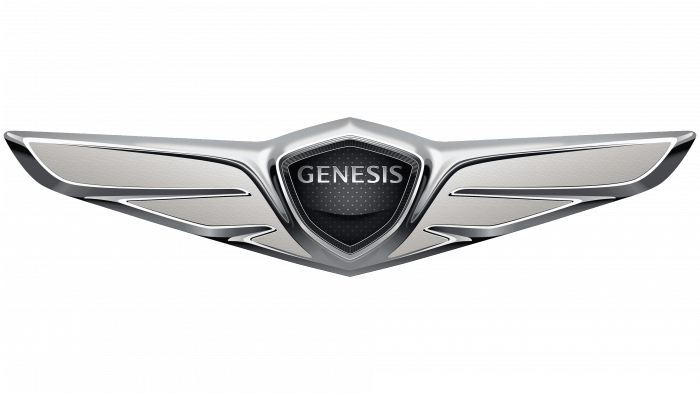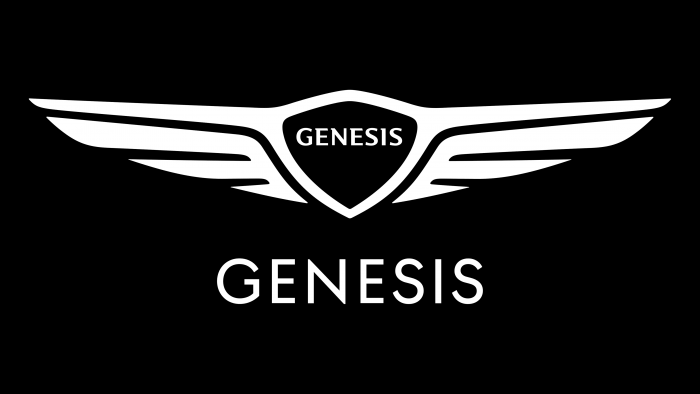The style of this emblem reflects the desire for flight and high speeds, so the Genesis logo is the epitome of the concept. The automotive manufacturer has focused on the aerodynamic qualities of the machines and the optimal streamlining of the body with airflow, which is reflected in the brand logo.
Genesis: Brand overview
Meaning and History
In 2003, Hyundai conceived a conceptually new passenger car model with a modern embodiment of a rear-wheel-drive system. According to the plan, it was a progressive sports sedan. 2007, she demonstrated the first model, which took three years to develop. Within the framework of the project, $ 500 million were spent, and 800 thousand miles traveled. After the tests, the parent company only sent the car to the North American International Auto Show.
According to Chris Hosford, Hyundai’s US spokesman, the Genesis series has gained an individual brand status for three reasons. First, these luxury cars have enjoyed great success for seven years. The second is that the sedan entered the top three in its segment in terms of sales. Third, the buyers wanted the unit to become independent.
The original Genesis Motors dealerships were Hyundai distribution centers, while the newly formed structure designed its vehicles. As a result, its SUV debuted in the winter of 2020 and an electric car in 2021. They bore the Genesis badge on the front, not the Hyundai Motor Group emblem. In general, this brand has three variants of the logo.
What is Genesis?
It is one of the car brands owned by the South Korean car manufacturer Hyundai Motor Company.
2008 – 2015
In the early years, the brand was called the Hyundai Genesis. His symbolism was based on a winged image. In the center was an angular shield with a striped background and a triple edging of white and black lines. Horizontally, it was crossed by a rectangle with the name of the automobile line. The word was written in light letters with sharp edges that replaced serifs.
The wings were located to the right and left of the central element. Each consisted of three wide “feathers” and a tail. Due to the correct distribution of light and shadows, they looked volumetric: the highlights were concentrated closer to the middle, and dark zones appeared at the ends of the “feathers” and under them. There was also a separately placed brand name: it was at the bottom and was an exact copy of the inscription from the center. The only difference was in color: one word was white, the other was black.
2015 – 2020
After the division was officially declared a standalone Genesis Motors brand, it received a new emblem. It was a reworking of the old version. The designers narrowed the fenders to make them more compact, removed the tail section, replaced the striped background with a dotted one, and reduced edging stripes around the shield. They chose a combination of black and gray in several shades as the official palette.
2020 – today
The developers have even simplified the logo, turning it into a laconic sign. They flattened it by eliminating the 3D effect, split the top “feather” into two separate parts, lightened the background, and tweaked the shield, after which it got a slightly different shape. In addition, the authors added a bottom caption and changed the font to a sleek, thin, sans serif.
Genesis: Interesting Facts
Genesis, Hyundai Motor Group’s luxury car division, has made a significant mark globally since becoming its brand in 2015.
- Start: Genesis began as the Hyundai Genesis sedan in 2008, and its success paved the way for becoming a standalone luxury brand in 2015.
- First Cars and Growth: Starting with the G90 and G80 sedans, Genesis has expanded to include smaller sedans like the G70 and SUVs such as the GV80 and GV70.
- Design Awards: Known for “Athletic Elegance,” Genesis has won several design awards for its vehicles’ looks and luxury interiors.
- Performance and Tech: Genesis cars are praised for their performance, safety, and advanced technology, including driver-assistance features.
- Global Presence: Initially focusing on South Korea and North America, Genesis is now entering markets worldwide, achieving notable sales and recognition.
- Electric Future: In 2021, Genesis introduced the GV60, its first electric model, showing its commitment to sustainable and electric vehicles.
- Luxury Services: Genesis offers unique services like valet appointments and connected services to enhance the ownership experience.
- Marketing: Genesis has used Super Bowl ads and celebrity endorsements to broaden its appeal and increase brand visibility.
- Sports Sponsorship: The brand sponsors the Genesis Invitational golf tournament, aligning itself with luxury and sporting excellence.
- Rapid Success: Despite being new to the luxury market, Genesis has quickly gained recognition for quality and customer satisfaction.
Genesis represents Hyundai Motor Group’s ambitious move into the luxury market, combining great design, cutting-edge technology, and a focus on customer service to redefine luxury car standards.
Font and Colors
The Genesis Motors brand identity evolved from voluminous and complex to flat and simple. As a result, a completely different logo appeared, with three independent blocks. The first is a shield with a name and two lines extending to the right and left. The second is two wings, which include three “feathers.” The third is the bottom caption in sans-serif capital letters.
To express the concept of Genesis Motors, the designers used the Hyundai Sans Typeface as the basis, slightly changing the proportions and detailing of the signs. This change aims to achieve a distinctive look that is quietly Iconic. Like the Genesis cars, the look is premium but not luxurious, refined, refined, and balanced. Guided by this principle, the developers embodied the individual appearance of the new brand without losing the DNA connection with the parent company.
The authors of the personal typeface first sharpened the corners a little, giving the letters a geometric look. Thus, they showed the extremeness of the machines. Then, they changed the proportions of the alphabet, guided by the Romanis Capitalis font, where straight characters are half the width of the rounded characters. The roll call with the ancient Roman sans-serif typefaces, as if carved from stone, set a new rhythm for the inscriptions—sophisticated and exclusive.
The logo’s color scheme is not far from the palette of the parent company. It contains all shades of gray—from light silver to dark graphite. They were used with a hidden gradient from light mid to dark edges. But this was only the beginning. Then, they were joined by monochrome, formed by combining black elements on a white background.
FAQ
When did Genesis change their logo?
The company began as a luxury car model under Hyundai and became its brand in November 2015. This change was accompanied by a new logo, denoting its place in the automotive industry as a separate entity. Hyundai aimed to enter the luxury car market by appealing to customers who value premium quality and exclusive design.
The logo, introduced in 2015, symbolizes Genesis’ independence and focus on luxury. The rebrand included a sophisticated badge to compete with established luxury automotive brands. The logo features a shield emblem representing security and prestige and a winged design representing speed, freedom, and elegance.
Are Genesis cars part of Bentley?
The cars are not part of Bentley. Hyundai’s luxury car division was created to compete in the premium car market. The brand originated as part of Hyundai, one of the largest car manufacturers in South Korea, known worldwide for its wide range of vehicles that combine affordability and reliability.
The company was created to carve a niche in the luxury car segment, providing high-end cars boasting advanced technology, exquisite design, and premium quality. The differences between the two brands are significant: each caters to different segments of the luxury car market and adheres to different heritage and brand values.
What does the Genesis logo mean?
The logo, which features two wings separated by a black shield and the word Genesis, symbolizes the brand’s premium status. The winged design is similar to luxury brands such as Aston Martin, Chrysler, and Bentley, which use wings to convey luxury, speed, and ambition.
The logo’s wings symbolize grace and perfection and are suitable for the luxury car market, where consumers look for status and achievement symbols. These images help the brand visually communicate high quality and superior performance. The black shield behind the brand name adds strength and protection, making the logo memorable and impactful.
Is Genesis a good car brand?
The company is known for its high-quality cars, especially modern models. The brand competes with luxury car manufacturers such as Mercedes-Benz, Lexus, and BMW, outperforming them in several ways.
Many models feature advanced technology, sophisticated design, and high-quality materials, standard features that are costly extras on other luxury cars. The cars are praised for their smooth handling, powerful engines, and responsive driving dynamics. They combine performance, elegant style, and a quiet, comfortable cabin, appealing to those seeking luxury without the hefty price tag. The brand offers generous warranty programs and customer service initiatives that enhance the ownership experience.
Why does the Hyundai Genesis have a different logo?
The company adopted a new logo to differentiate itself from Hyundai and establish itself as a separate luxury brand. Initially, the models bore the Hyundai logo because they were part of the Hyundai lineup.
As Genesis evolved into its brand, establishing a unique identity became important. This helps differentiate the vehicles from mainstream Hyundai models. Some owners add a wing badge to their vehicles, which are sold separately. This logo choice highlights the luxury of the cars. The elegant and sophisticated design of the badge conveys sophistication, meeting the expectations of luxury car buyers better than the Hyundai logo.
Who makes the Genesis?
Hyundai owns and produces the brand, launched as a separate company in 2015 to enter the luxury car market.
Creating a separate brand for luxury models allows Hyundai to focus on design, technology, and customer service tailored to luxury car buyers. This approach helps the brand create a unique identity and driving experience, setting it apart from Hyundai’s more utilitarian vehicles. By maintaining ownership and production, Hyundai ensures Genesis benefits from its research, development, and quality control processes.
